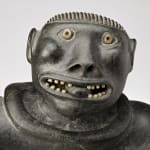JUDAS ULLULAQ (1937-1999) Uqsuqtuuq (Gjoa Haven)
signed, "ᐅᓗᓚ".
LOT 23
ESTIMATE: $18,000 — $28,000
Further images
-
(View a larger image of thumbnail 1
)

-
(View a larger image of thumbnail 2
)

-
(View a larger image of thumbnail 3
)

-
(View a larger image of thumbnail 4
)

-
(View a larger image of thumbnail 5
)

-
(View a larger image of thumbnail 6
)

-
(View a larger image of thumbnail 7
)

-
(View a larger image of thumbnail 8
)

Judas Ullulaq began carving whale bone in Taloyoak in the late 1960s but created art only sporadically throughout the 1970s; in fact there are virtually no documented pieces by him from this period. Having absorbed the artistic influence of his nephew Karoo Ashevak (1940-1974) and other Taloyoak carvers, Ullulaq moved to Uqsuqtuuq (Gjoa Haven) in 1982. He quickly forged a strong personal style, had two successful solo shows in 1983, and soon became the most beloved and influential artist in the Kitikmeot region.
Excited Fisherman is similar in style to Ullulaq’s delightful Drum Dancer from c. 1983 (see First Arts Auctions, July 2020, Lot 39), and was carved perhaps a year later. It is even closer in style to the artist’s Tiqmiaqhiuqtuq (Bird Hunter) of 1984 (see Darlene Wight’s WAG Netsilik catalogue, cat. 148). In that landmark catalogue Wight notes that the expressive faces of Ullulaq’s hunters and fishermen are self-portraits; we absolutely agree - Ullulaq’s cheerfulness and sense of humour, and his infectious smile and lively eyes are fondly remembered by those who knew him, and we see a strong resemblance with Excited Fisherman. The sculpture is a masterpiece of Ullulaq’s early mature style. The fisherman’s body is not highly detailed but it is realistic in its pose and beautifully modulated and finished; Ullulaq also pays careful attention to the kakivak (fishing spear) and jigger. But the artist has lavished special attention on the head and face. Excited Fisherman sports one of the most expressive, engaging, and charming visages ever created by the artist; with its trademark meticulously carved and slightly exaggerated features, and inlaid muskox horn eyes and teeth, the face is bound to elicit a smile from even the most jaded of viewers.
Literature: For a contemporaneous example of a similar subject by the artist see Darlene Coward Wight, Art & Expression of the Netsilik (Winnipeg Art Gallery, 2000), cat. 149; the section on this important artist in Wight’s Netsilik catalogue is extensive, pp. 152-171. See also Innuit Gallery of Eskimo Art, Ooloolah Spence Bay (Toronto: 1983), solo exhibition catalogue; Canadian Arctic Producers, Judas Ooloolah (1983), solo exhibition catalogue. For more thematically related works see Ingo Hessel, Arctic Spirit: Inuit Art from the Albrecht Collection at the Heard Museum (Vancouver: Douglas & McIntyre/Phoenix: Heard Museum, 2006), pp. 126-127.
Provenance
Ex. Coll. Don Morgan, Toronto;
Acquired from the above by Fred and Mary Widding, Ithaca, NY. January 2001.
Exhibitions
Ithaca, NY, Handwerker Gallery, Gannett Center, Ithaca College, Of the People; Inuit Sculpture from the Collection of Mary and Fred Widding, 26 February - 6 April 2008, cat. no. 25.Publications
Cheryl Kramer & Lillian R. Shafer eds., Of the People; Inuit Sculpture from the Collection of Mary and Fred Widding, exh. cat., (Ithaca, NY: Handwerker Gallery, Gannett Center, Ithaca College, 2008), reproduced, cat. no. 25;
“Artists Speak: Judas Ullulaq”, Inuit Art Quarterly, Vol. 14, No. 22, Summer 1995, p. 18.
Join our mailing list
* denotes required fields
We will process the personal data you have supplied in accordance with our privacy policy (available on request). You can unsubscribe or change your preferences at any time by clicking the link in our emails.








